Please Take Note: This is a review of the final game, but it might change slightly based on the success of the Kickstarter campaign. The game is being reviewed on the components and the rules provided with the understanding that “what you see is not what you might get” when the game is published. If you like what you read and want to learn more, we encourage you to visit the games website or Kickstarter campaign. Now that we have all that disclaimer junk out of the way, on with the review.
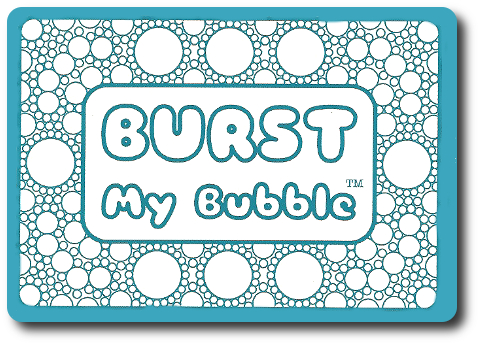
The Basics:
- For ages 10 and up
- For 3 to 6 players
- Approximately 1 hour to complete
Geek Skills:
- Active Listening & Communication
- Counting & Math
- Logical & Critical Decision Making
- Reading
- Strategy & Tactics
- Risk vs. Reward
- Hand/Resource Management
Learning Curve:
- Child – Easy
- Adult – Easy
Theme & Narrative:
- Make bubbles and then pop them like crazy
Endorsements:
- Gamer Geek rejected!
- Parent Geek approved!
- Child Geek approved!
Overview
Soap and soap bubbles are often thought of as the very definition of clean. Using soap, a person can wash clothes, dishes, windows, and just about anything else you can think of. In this game, however, you will be getting down and dirty while at the same time trying your very best to rise above and emerge as squeaky clean as possible. You’ll have to balance the grime with the shine if you want to win.
Burst My Bubble, designed by Dan Crutchfield, Ryan A Smith and to be published by Purple Potato Games, will reportedly be comprised of 144 cards. As this is a review of a prepublished game, I cannot comment on the game component quality. Illustration by Mike Bocianowski are lighthearted and family friendly. Not included with the game, but necessary to play, is a pen or pencil and some paper to record players’ scores.
Adding Soap to Water
To set up the game, set aside a certain number of a specific type of cards based on the number of players and shuffle. Place the deck of cards face-down in the middle of the playing area, with the Drain card on one side and the Sponge card on the other side. Scored cards are placed on the Drain card. All discarded cards are placed on the Sponge card.
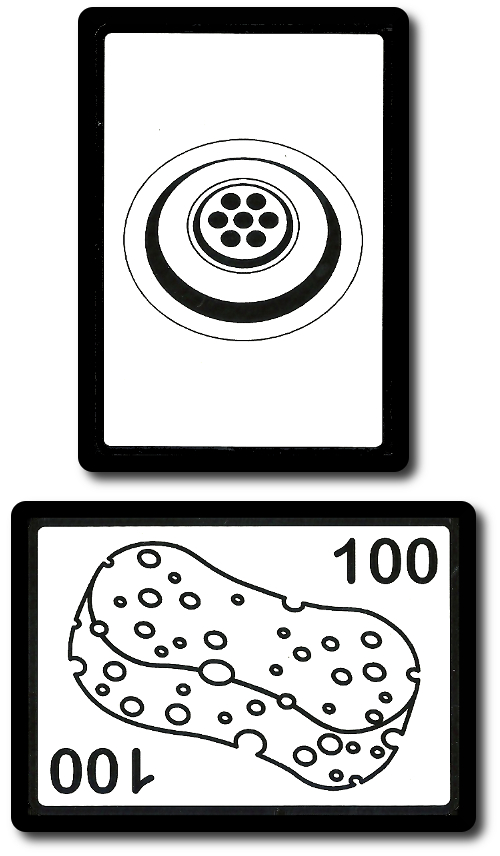
Second, deal 5 cards to each player, face-down. This is the player’s starting hand. Cards should be kept hidden until played. If a player has a “It’s On!” card or an “Unstable Bubble” card, they should play them immediately.
That’s it for game set up. Determine who will be the first player and begin.
Soap In Your Eye
Burst My Bubble has several different types of cards. Each card type plays a specific role in the game. The cards types are summarized here.
Common Cards
Common cards fall into five different subtypes. These are “Bubble”, “Unstable Bubble”, “Pop”, “Buster”, and “Action” cards.
“Bubble” cards come in values of 10, 20, and 30 and are used to create “Bubble Streams”. Once the bubble is burst, they can be added to sets. “Unstable Bubble” cards also come in values of 10, 20, and 30. They are played directly to the “Bubble Stream”.
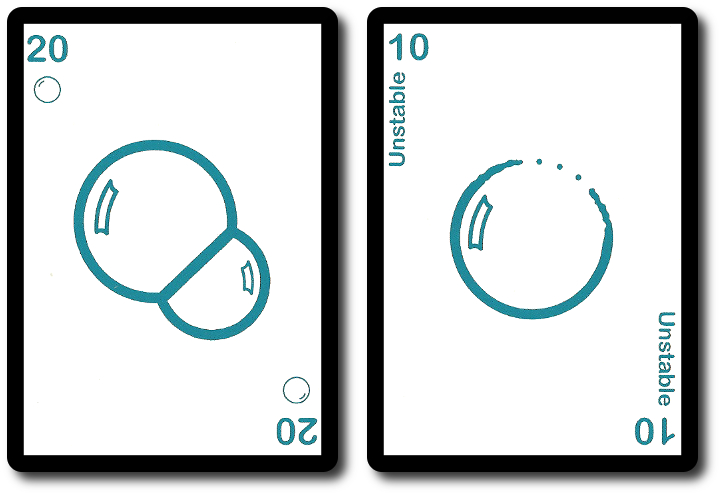
“Pop” cards are played during a specific phase of the game and come in values of 10, 20, and 30. “Pop” cards must burst a “Bubble” card in order to be played, wherein one or more “Pop” cards can be played to a “Bubble Stream”. “Buster” cards can only be played once during a single turn but can be “chained” to create additional points, bursting multiple “Bubble” cards.
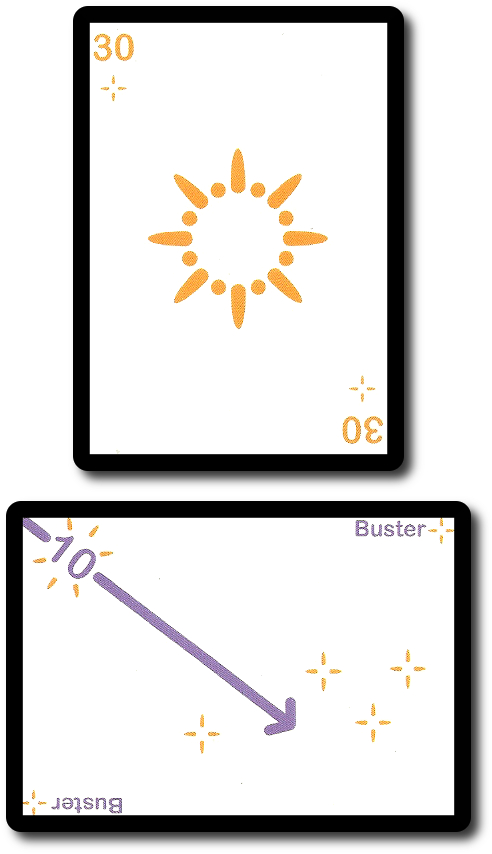
“Action” cards allow the player to take additional actions that are not commonly available. For example, the player can burst an opponent’s bubbles, look at cards in the draw deck, and even trade cards.
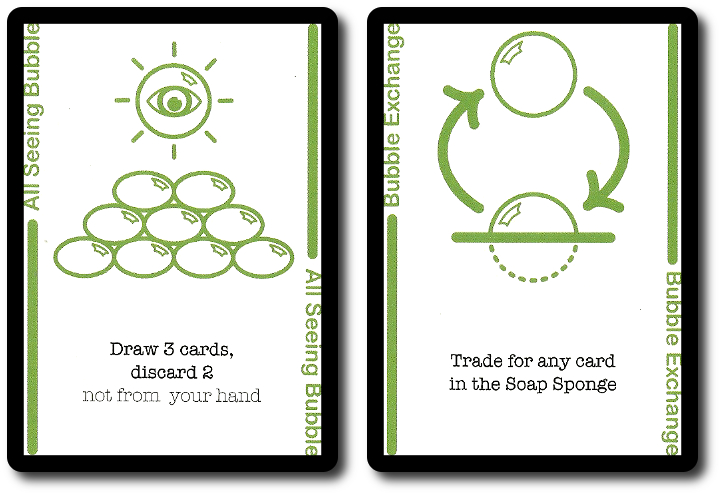
Hero Bubble Cards
Hero Bubble cards provide specific abilities that may or may not be beneficial to the active player. Hero Bubble cards must be played when they are in the player’s hand. Nesting Hero Bubble cards allow the player to modified other cards by playing them to the corners of the Nesting Hero Bubble card. The Nesting Hero Bubble card is played to the player’s Bubble Stream and will remain active for as long as it’s in play.
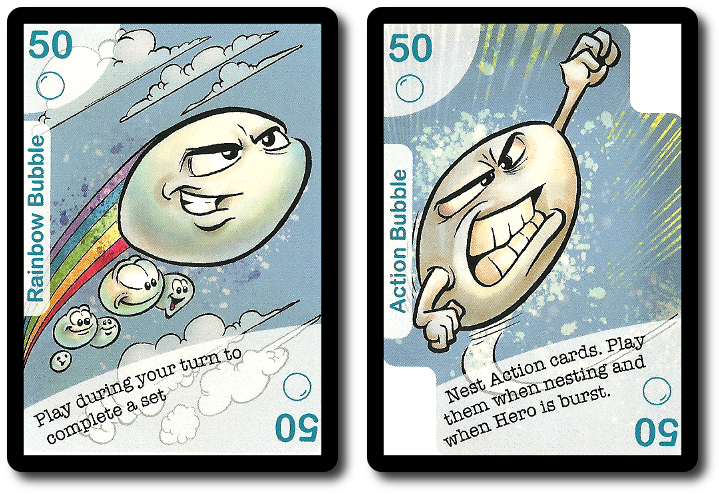
Defense Cards
The Defense cards are used during the “Burst My Bubble” phase of the game. Some Defense cards allow you to nest other cards, much in the same way as a Nesting Hero Bubble card.
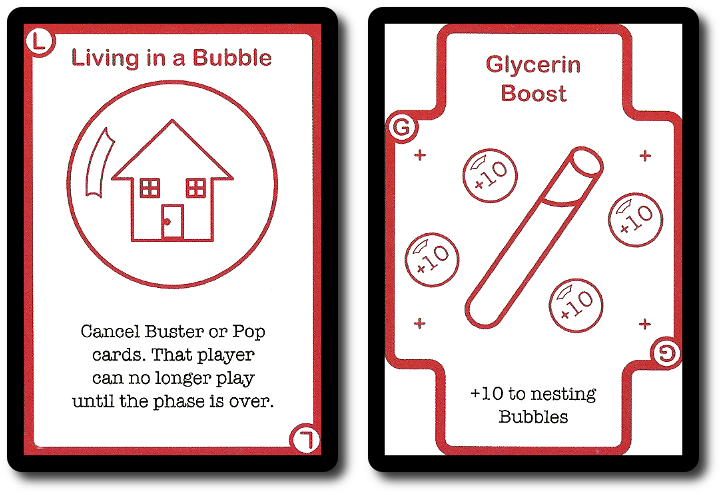
Special Cards
Special cards include the Soap and Drain card, as well as the Foam and It’s On! card. They have a special role in the game and are used to both score and cause mischief.
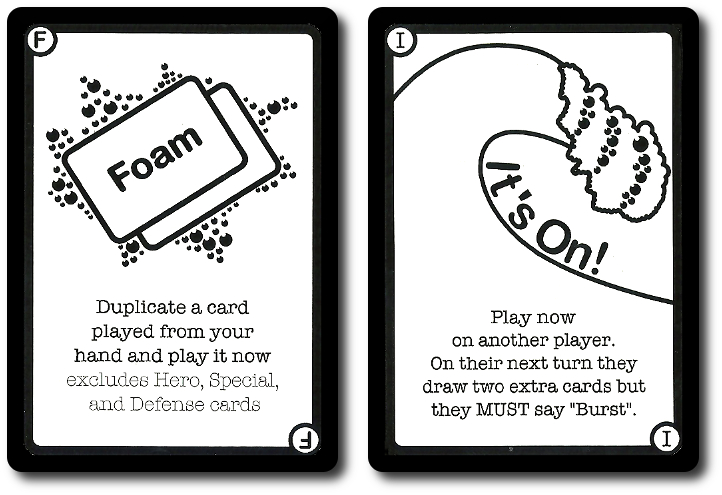
Clean Plays, Dirty Tricks
Burst My Bubble is played in rounds and phases, with no set number of rounds per game. A round is summarized here.
Bubble Up Phase
Starting with the first player and continuing clockwise, each player completest the following actions.
- Bubble Up: The player always takes this action, allowing them to draw 2 cards from the draw deck, adding them to their hand. There is no limit to the number of cards a player can have in their hand.
- Play one Action card if the player wants to (optional)
- Initiate the “Burst My Bubble” phase if the player wants to (optional)
- Pass: This ends the player’s turn. The “Burst My Bubble” phase is skipped.
Burst My Bubble Phase
This phase only happens if the active player initiates it during their turn. The player to initiate this phase is referred to as the “Bubble player” who will be attempting to make as many points as possible by collecting cards from the Sponge card pile. All other players are referred to as “Bursting players” who earn points by busting bubbles.
The Bubble player takes the following actions in sequential order:
- Draws a number of cards and adds them to their hand. The number of cards drawn is determined by the number of players in the game.
- Play one Action card (optional)
- Play to Bubble Stream (Common, Hero, Bubble, and nesting cards). To create a Bubble Stream, all common and Hero Bubble cards must be played. Certain Special cards may also be added, as well as a few Defense cards. Cards are arranged in front of the player.
The Bursting players do not draw cards. Instead, they take the following actions:
- Burst Bubbles: Players take turns busting any bubbles on the Bubble player’s Bubble Stream by using Buster cards. Buster cards can bust multiple bubbles, adding to the total number of cards in play in front of the player which will count as points later in the game. Players can also play Pop cards, but these target single bubbles.
- Play one Action card (optional)
- Pass (ending their turn during the Bust My Bubble phase)
Table Reset Phase
This phase only happens if none of the bubbles were busted in the Bubble player’s Bubble Set during the Burst My Bubble phase. The Bubble player places all their remaining cards on the Sponge discard pile. This includes cards in the player’s hand, cards in the player’s Bubble Stream, incomplete sets, and a few other cards. The cards are then scored. All Bursting players add points, too, but only score their incomplete sets and then subtract from that the total number of points that remain in their hand. All the cards are then reshuffled and each player is dealt 5 new cards.
Cleaning the Sink
The game ends after a table reset occurs and at least one player has 1200 points or more. Sets of cards earn extra points. For example, a set of four “10’s” will earn the player 100 points, while cards that are not in a set only provide a number of points worth the number listed on them. The player with the most points wins the game!
Game Variant
If you find that a game is taking too long, you can shorten it (or lengthen it) by changing the required number of points to win. I suggest you limit the number of points needed for victory to 1000 for your first game. It should make the game about 45 or so minutes long.
To learn more about Burst My Bubble, visit the games website or Kickstarter campaign.
Final Word
 The Child Geeks enjoyed the game, finding it fun and challenging to create different sets and then timing their scoring just right to make as many points as possible. The only aspect of the game they did not like was the number of negative points a player could earn during scoring. Since the game allows players to hold as many cards as they like, this led to the Child Geeks having very large hands. Hands of cards so huge that they sometimes became unruly. When it came time to score, Child Geeks with lots of cards in their hand oftentimes lost so many points as to go into the hole with negative points. According to one Child Geek, “I like the game, but I hate the scoring. It makes you feel like you are taking one step forward and ten or more steps back.” When the games were over, the Child Geeks looked past the scoring issues and decided the game was good enough to endorse.
The Child Geeks enjoyed the game, finding it fun and challenging to create different sets and then timing their scoring just right to make as many points as possible. The only aspect of the game they did not like was the number of negative points a player could earn during scoring. Since the game allows players to hold as many cards as they like, this led to the Child Geeks having very large hands. Hands of cards so huge that they sometimes became unruly. When it came time to score, Child Geeks with lots of cards in their hand oftentimes lost so many points as to go into the hole with negative points. According to one Child Geek, “I like the game, but I hate the scoring. It makes you feel like you are taking one step forward and ten or more steps back.” When the games were over, the Child Geeks looked past the scoring issues and decided the game was good enough to endorse.
 The Parent Geeks enjoyed the game and particularly liked the fact that players were penalized during scoring. A complete reversal of the Child Geeks. According to one Parent Geek, “I like how the game lets you collect as many cards as you want. It is like the game gives you all the rope in the world to hang yourself if you really want to.” Another Parent Geek said, “The cards allow the players to have some interaction, but it is mostly a game about managing your own cards. I like how there is no limit to the number of cards you are holding and I like it even more than you are penalized for not playing cards out of your hand!” When all the games were over, the Parent Geeks found Burst My Bubble to be a fun game to play with just their group and with the family.
The Parent Geeks enjoyed the game and particularly liked the fact that players were penalized during scoring. A complete reversal of the Child Geeks. According to one Parent Geek, “I like how the game lets you collect as many cards as you want. It is like the game gives you all the rope in the world to hang yourself if you really want to.” Another Parent Geek said, “The cards allow the players to have some interaction, but it is mostly a game about managing your own cards. I like how there is no limit to the number of cards you are holding and I like it even more than you are penalized for not playing cards out of your hand!” When all the games were over, the Parent Geeks found Burst My Bubble to be a fun game to play with just their group and with the family.
 The Gamer Geeks were not impressed and found Burst My Bubble to be a boring. According to one Gamer Geek, “The game has some good ideas, but it never felt like I was really going anywhere. I didn’t feel engaged, nor did I feel like I was having fun.” Another Gamer Geek said, “I think the game would be good for families, but for me and my crew, this game is an absolute dud. I don’t think it was designed for gaming elitists, so I won’t pound on it too hard.” The overall feeling from the Gamer Geeks was that Burst My Bubble was a game that was trying too hard at times and not at all during others. It felt middle of the road, at best, and at worst, like roadkill. When the games were over, the Gamer Geeks washed their hands of Burst My Bubble and voted it down.
The Gamer Geeks were not impressed and found Burst My Bubble to be a boring. According to one Gamer Geek, “The game has some good ideas, but it never felt like I was really going anywhere. I didn’t feel engaged, nor did I feel like I was having fun.” Another Gamer Geek said, “I think the game would be good for families, but for me and my crew, this game is an absolute dud. I don’t think it was designed for gaming elitists, so I won’t pound on it too hard.” The overall feeling from the Gamer Geeks was that Burst My Bubble was a game that was trying too hard at times and not at all during others. It felt middle of the road, at best, and at worst, like roadkill. When the games were over, the Gamer Geeks washed their hands of Burst My Bubble and voted it down.
 Burst My Bubble challenges players to think in multiple directions at once. One of the issues I had is that the game didn’t ever make it obvious that I had to. Better put, the first couple of games felt like I was playing in the dark, making decisions based on the current situation, rather than planning my plays out in a strategic and tactical fashion. It wasn’t that I felt like I was just reacting. More like I didn’t feel like I could act in such a way as to make meaningful progress. The game’s length reflects this, with a normal game ending at 1200 points taking about an hour.
Burst My Bubble challenges players to think in multiple directions at once. One of the issues I had is that the game didn’t ever make it obvious that I had to. Better put, the first couple of games felt like I was playing in the dark, making decisions based on the current situation, rather than planning my plays out in a strategic and tactical fashion. It wasn’t that I felt like I was just reacting. More like I didn’t feel like I could act in such a way as to make meaningful progress. The game’s length reflects this, with a normal game ending at 1200 points taking about an hour.
Once you understand the game, however, you start to see the subtle strategic game plays you can make and the tactical moves. I wouldn’t say that the game is highly strategic or tactical, but it does leave the door open for the players to act as such. Case in point, initiating the Burst My Bubble phase should only be done when you think you have a great chance of earning points and skunking as many players as possible. Play that card too soon, and you’ll end up wasting your time and revealing too much of your hand, making it easier for opponents to take advantage of you during the next couple of rounds. As such, Burst My Bubble is a game that focuses more on timing. It’s not enough to set up your cards. You have to know when to play them and score them, as well.
Overall, I am neither pleased or displeased with the game. It entertained to a point and kept our Child Geeks and Parent Geeks entertained. The Gamer Geeks disliked the game, which doesn’t come as a big surprise, but it does suggest that Burst My Bubble is not a game for those looking for a gaming experience rich with strategic depth and tactical maneuvers. For everyone else, I think you’ll find Burst My Bubble to be somewhere in between a casual game and more complex game, as the time it takes to play it and the constant possible setback of reduced points making each hand a lot more than random card plays. Do try Burst My Bubble and find out if this game washes all your game needs clean.
This is a paid for review of the game’s final prototype. Although our time and focus was financially compensated, our words are our own. We’d need at least 10 million dollars before we started saying what other people wanted. Such is the statuesque and legendary integrity of Father Geek which cannot be bought except by those who own their own private islands and small countries.



